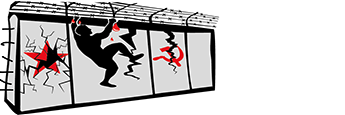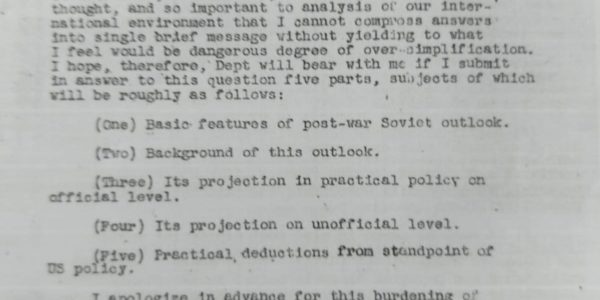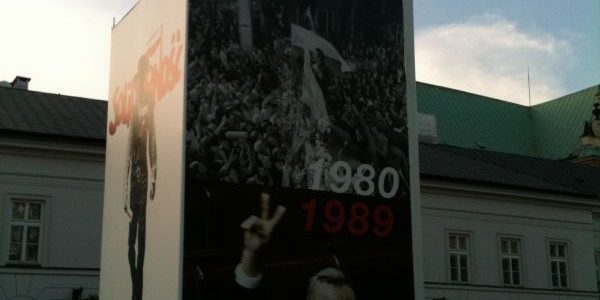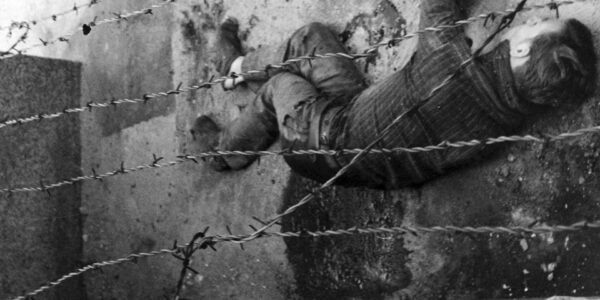The first major popular uprising against communist oppression in Central/Eastern Europe
by Patrick van Schie
Between 1954 and 1990, June 17 was the Tag der deutsche Einheit in West Germany, which is then celebrated on October 3 – the day of reunification. With this, the West Germans commemorated until 1990 that on June 17, 1953, now seventy years ago, workers in the eastern Soviet occupation zone, the GDR, rose up against the communist regime. It was the first major popular uprising against communism in any of the satellite states occupied by the Soviet Union since the end of World War II. The uprising was bloodily suppressed by tanks of the Red Army.
The run-up
As in the other satellite states in Central and Eastern Europe, Germany’s Red Army-occupied “Eastern Zone” was rapidly “equalized” after World War II, i.e. subjected to Communist autocracy with all the attendant terror and a rigid economic planning system . The German Democratic Republic (GDR) was founded in 1949. As puppets of Moscow, the leaders of the Sozialistische Einheitspartei Deutschlands (SED) formally ruled it, to the outside world this was a fusion party of communists and social democrats, although in reality it was a thoroughly communist party. The GDR was a ‘people’s republic’, communist jargon for a dictatorship in which the people had nothing to say and the party leadership had everything to say.
After Stalin’s death on March 5, 1953, the reins in Moscow were loosened somewhat; if not in the GDR. On April 20, the SED leadership decided to raise the prices of rationed foodstuffs. More than a month later, on May 28, the decision followed that production standards were increased by 10.3%, in other words: the workers had to work longer. Together, these measures amounted to a reduction in hourly wages of 25-30%!
This was too much for even the leaders of the Soviet Union. East German party leader Walter Ulbricht and GDR Prime Minister Otto Grotewohl, together with the SED’s chief of ideology, were summoned to Moscow from 2 to 4 June, where they were told to implement reforms. These were announced on June 11 and included, among other things, travel relaxations to the ‘west zones’ (West Germany), revision of some judgments from previous years, an end to the Kirchenkampf (the undermining of the Evangelical church) and the purge of teaching staff, a halt to the collectivization of agriculture and a shift in production from heavy industry to consumer goods.The GDR population was skeptical of the party’s sudden sense of reform, which had been forced on the SED leaders in the Kremlin. In addition, the announced measures lacked a revocation of the announced labor standards. While strikes had already broken out in Bulgaria (near Plovdiv) at the beginning of May and then closer in Czechoslovakia about 360,000 workers went on strike in Plzen and other cities, in June the GDR pan caught fire.
The demands of the workers and the uprising
On Friday, June 12, 1953, the first strike broke out in the GDR (which was banned in the so-called “workers’ republic”). On Monday, June 15, construction workers who were working on the construction of a hospital stopped work in East Berlin’s Friedrichshain. The next day, hundreds of construction workers from workers’ flats on Stalinallee in the center followed. The group of strikers now swelled rapidly and the strikes and protests spread across the country. In no time, 600 factories were on strike.
On Wednesday, June 17, workers in East Berlin marched to government buildings. Their initial slogan ‘Nieder mit den Normen!’ was soon replaced by ‘Wir fordern freie, heime Wahlen’ and the call for the resignation of Ulbricht and Grotewohl. The economic turmoil had turned into a political revolt against communism.
The communist leaders reacted as usual. The deputy head of the official union, a figurehead of the regime, called criticism of labor standards “an attack on the interests of the workers”. Prime Minister Grotewohl said that “fascist agents from the West” were behind the strikes. But the GDR leaders were no longer in control and fled to a place guarded by soldiers from the Soviet Union.
Party offices of the SED were attacked in several places in the country. The red flag was removed from the Brandenburg Gate and a German as well as a Berlin flag were raised instead. In 14 cities, the insurgents succeeded in capturing city halls, and two buildings belonging to the security service also fell into their hands. A prison was stormed in the town of Halle; 251 prisoners were freed. The regime declared a state of emergency in more than 80% of all (217) East German districts.The communist leaders in the Soviet Union had already concluded the night before that the East German regime was in danger of collapse and that intervention was necessary. In the late morning of June 17, several hundred Soviet tanks appeared on the streets of East Berlin. Shortly after noon, they opened fire on the insurgents, whose numbers had swelled to about 150,000 in the East German capital. Across the country, more than 1 million people – men, women and children – probably took part in the protests (estimates vary quite widely, from 400,000 to 1.5 million), spread over 550 to 700 cities.
Repression and aftermath
In several places, the demonstrators pelted the tanks with stones, an act of desperation that of course had no effect. In the fighting, the approximately 20,000 Soviet soldiers deployed, aided by 8,000 men from the Kasernierte Volkspolizei, killed an estimated between 300 and 400 civilians. Some 15,000 arrests were made. At least 1526 sentences followed, including two death sentences, three life sentences, while the rest received prison sentences of up to fifteen years.
The East German party leader Ulbricht, whose position was still shaky before the uprising, regained his footing and was awarded the honorary title of ‘Hero of Labour’ on 30 June, his 60th birthday. In the Kremlin, the uprising in the GDR prompted General Secretary Khrushchev and his allies to deal with Beria, who had initiated the course of reform and forced it on the GDR leadership. Beria, who had been chief of the forerunner of the KGB for many years, was executed six months later.
Among the 32,000 refugees who migrated from the GDR to the West in June 1953 (the Wall had not yet been erected), there were at least 336 VoPos.( The Deutsche Volkspolizei – Eastern German People’s Police). The regime, meanwhile, tightened its reins again. Under pressure from the Kremlin, the SED had been forced to admit mistakes in the days before the uprising. The SED would never do that again for the rest of its rule over the GDR. The next time the East German communists were told by the Soviet leadership (Gorbachev) to reform, in October 1989, their regime was beyond saving. After all, without the violence of Soviet tanks, the power of the communists was based on nothing.
Video: https://www.bundesfinanzministerium.de/Content/DE/Video/Geschichte/volksaufstand/volksaufstand.html
Image: Wikipedia: Russian IS-2 tank on the streets of Leipzig, June 1953
Bundesarchiv, B 285 Bild-14676 / Onbekend / CC-BY-SA 3.0, https://nl.wikipedia.org/wiki/Volksopstand_in_de_DDR_(1953)#/media/Bestand:Bundesarchiv_Bild_175-14676,_Leipzig,_Reichsgericht,_russischer_Panzer.jpg




Follow Us!